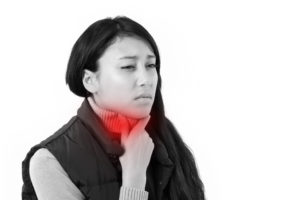August 22, 2017 | Black & Kletz Allergy

Eosinophilic esophagitis (EoE) is a chronic inflammatory condition caused by the abnormal accumulation of eosinophils (a type of white blood cell) in the lining of the tube carrying food from the throat to the stomach (i.e., esophagus).
Cause:
EoE is a relatively newly discovered condition and is being diagnosed with increasing frequency in the past decade in all age groups. Though the exact cause of the condition is still being investigated, food and environmental allergies are suspected to play a role as it is often associated with other atopic disorders like seasonal allergies (i.e., allergic rhinitis), asthma, and eczema (i.e., atopic dermatitis). Both genetic and environmental factors are theorized to contribute to this condition.
Mechanism:
Eosinophils release various proteins that cause damage to the structure of the esophagus resulting in ridges, furrows, scarring, and narrowing of the lumen of the tube.
Symptoms:
Children:
- Irritability
- Feeding difficulties
- Failure to thrive
- Vomiting
- Abdominal pain
Adults:
- Difficulty in swallowing (particularly solid foods)
- Heartburn/indigestion
- Pain or discomfort of the chest
- Abdominal pain in the upper abdomen
Diagnosis:
- Upper gastrointestinal endoscopy and biopsy: A flexible tube with a light source and a tiny camera (i.e., endoscope) is passed through the mouth down through the esophagus and the lining of the esophagus is closely examined. A small piece of the lining is biopsied and examined under a microscope. Accumulation of eosinophils in the lining of the esophagus confirms of the diagnosis of EoE.
- Skin prick tests and/or blood tests to foods in order to rule out food allergies as a cause. This is often coupled with a food elimination diet.
- Skin patch tests in order to detect delayed hypersensitivity to foods.
- Skin tests to environmental allergens such as pollens, especially when the symptoms of EoE exhibit a seasonal pattern.
Management:
- Restriction of certain specific foods in the diet based on skin prick and/or patch test results.
- Empiric elimination diets starting with dairy, wheat, eggs, soy, peanuts, tree nuts, fish, and shellfish (preferably under the guidance of a dietician) and gradually reintroducing one food at a time while closely monitoring the symptoms and follow-up biopsies.
- Medications: There are currently no FDA approved medications specific to EoE, but the following medications are commonly employed in the treatment of the condition refractive to dietary management.
- In a subset of individuals with EoE called Proton pump inhibitor-responsive esophageal eosinophilia (i.e., PPI-REE), medications called proton pump inhibitors (i.e., PPI’s) are used to reduce acid secretion in the stomach. Medications in this category [e.g., omeprazole (Prilosec); esomeprazole (Nexium)] can greatly help in relieving the symptoms.
- Topical corticosteroids which are usually utilized in inhalers to treat asthma [e.g., fluticasone (Flovent); budesonide (Pulmicort)] can also be helpful in EoE when ingested in a slurry form. They can control the structural damage to the esophagus due to their anti-inflammatory properties.
- When the disease is more severe and non-responsive to topical medications, systemic corticosteroids (e.g., prednisone, prednisolone, methylprednisolone) may be needed for a short duration.
- Newer anti-inflammatory drugs and biologicals are being researched in clinical trials at this time and may be available in the near future.
- In cases of severe narrowing of the esophagus, a procedure to dilate the esophagus by breaking up the strictures may help in relieving swallowing difficulties.
EoE is a complex immune system disorder with a chronic and relapsing course that has no known cure at this time. Optimal management of the condition requires coordinated care by an experience board certified allergist, gastroenterologist, and nutritionist/dietician.
The board certified allergists at Black & Kletz Allergy will readily respond to your needs for further information and services in dealing with EoE and other allergic and immunologic disorders. The allergy specialists at Black & Kletz Allergy have 3 convenient locations in the Washington, DC, Northern Virginia, and Maryland metropolitan area. Our offices are located in Washington, DC, McLean, VA (Tysons Corner, VA), and Manassas, VA. We offer on-site parking at all of our offices and our Washington, DC and McLean, VA offices are Metro accessible. There is a free shuttle that runs between our McLean, VA office and the Spring Hill metro station on the silver line. To make an appointment, please call our office or alternatively, you can click Request an Appointment and we will respond to your inquiry within 24 hours by the next business day. Black & Kletz Allergy treats both children and adults and we strive to provide the best and most current diagnostic and treatment modalities in the Washington, DC metro area, as we have done for more than 50 years.












